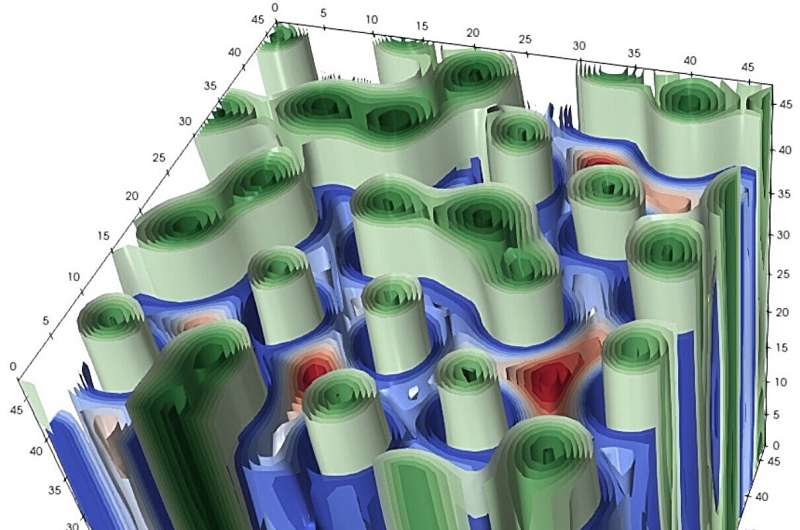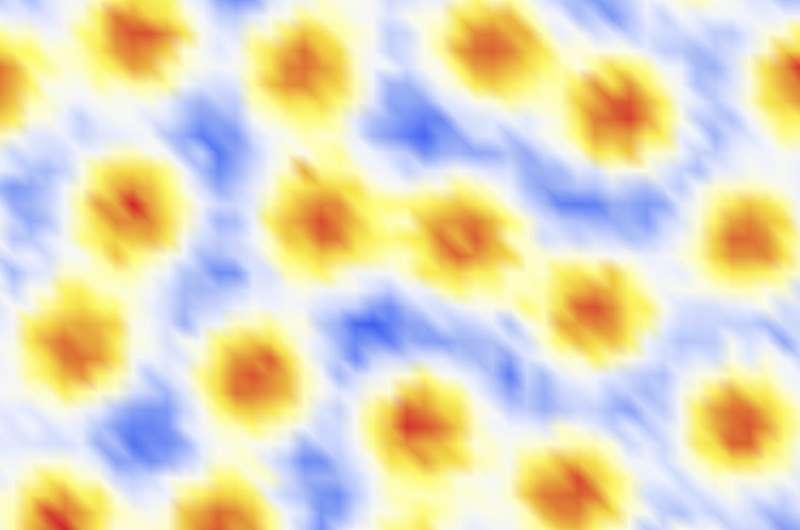January 18, 2024 dialog
This article has been reviewed according to Science X's editorial process and policies. Editors have highlighted the following attributes while ensuring the content's credibility:
fact-checked
peer-reviewed publication
trusted source
written by researcher(s)
proofread
Making a superconductor liquid–solid out of the vacuum with hundred-exatesla-strong magnetic fields

The discovery of superconductivity more than a century ago has significantly changed our world.
The story began in 1911 when the Dutch physicist Heike Kamerlingh Onnes observed that the electrical resistance of mercury abruptly dropped to zero when it was cooled to a temperature of about 4 Kelvin (approximately 269°C)—a bit colder than the boiling point of liquid helium.
The practical applications of this remarkable effect were realized much later, in 1986, when a class of high-temperature superconductors was discovered. These high-Tc materials have a critical temperature below the boiling point of liquid nitrogen, about −196°C, which reduces the complexity and cost of their operation.
Nowadays, the beneficial consequences of the discovery of superconductivity are impossible to overestimate. This phenomenon gradually enters our daily lives, although the unique role it plays is not readily visible.
The persistence of electric currents in superconducting material implies no energy losses in superconducting circuits, bringing into operation high-speed Maglev Trains that use magnetic levitation to reduce the energy friction almost to zero.
The no-resistance-flow of electricity paves the way for promising fast-response energy accumulators (Superconducting Magnetic Energy Storage) and serves as a core of Magnetic Resonance Imaging devices (known widely as "MRI") that are extensively used in hospitals and medical research centers.
Superconductivity emerges as a result of the formation of the electron pairs bound together by quanta of lattice vibrations (phonons). At low temperatures, these Cooper pairs condense and form a coherent superposition of states, a bosonic condensate, that move through the crystal lattice without scattering, resulting in zero electrical resistance.
The condensation of Cooper pairs also leads to the expulsion of magnetic fields from the superconductor—a phenomenon known as the Meissner effect—which is not explainable by merely the absence of electrical resistance. The aversion between the magnetic field and superconductivity is a mutual feeling shared by both parties, as the magnetic field destroys the superconducting state should the latter be unable to repel it via the Meissner effect.
The magnetic fields involved have the strength of the order of a hundred Tesla for certain high-Tc superconductors. In contrast, other superconducting materials cannot withstand even much weaker fields, with a fraction of one Tesla.
To get an idea about the strength of the magnetic field involved, one Tesla is the strength of the magnetic field in an ordinary loudspeaker. An MRI employs superconducting coil magnets that generate fields of the same scale, up to 2 Tesla, as electric current passes through them.
To summarize, superconductivity, exhibited by certain materials, is known to be vulnerable to strong magnetic fields.
Now, we come to the controversial question of the work published in Physical Review Letters that I have coauthored: Can we make a superconductor without the use of any material by employing only a magnetic field? This question sounds both controversial and not particularly clever, given what we have just described so far.
First, to get a superconducting state, we need matter —in the form of the Copper pairs. Second, it seems that we must avoid exposing this state to magnetic fields that are too strong, as those can destroy the superconducting flow.
The no-material requirement means that we are encouraged to work with "nothing" as our ... well, "material." Here, "nothing" means the most empty nothingness we can reach, that is, a vacuum. The vacuum, by definition, contains no matter, no particles, and no energy. Applying a strong magnetic field to the vacuum sounds like a hopeless idea, as the magnetic field has nothing to influence in it.
However, the vacuum is not entirely empty, thanks to the Heisenberg uncertainty principle, a cornerstone of quantum physics. The vacuum is stirring with the activity of virtual particles that pop up and disappear for short moments, forming a boiling soup of quantum fluctuations.
Our team, using advanced first-principle numerical simulations, has demonstrated that a sufficiently strong magnetic field causes these quantum fluctuations to materialize in the form of a solid. This solid appears to be made of vortex-like matter, with individual vortices being approximately streamlined along the magnetic field. The existence of such a solid has been hypothesized at the end of the 1980s, with a first-principle proof of its very existence lacking before our work.
To add more perplexity to our finding, we mention that this exotic solid also has specific characteristics of a liquid: The vortices wobble and move, as in a liquid, but remain approximately fixed to particular positions as in a solid. Contrary to a typical solid, we observe no crystal structure at any moment. Contrary to a liquid, the vortex constituents of this strange material do not exchange their spatial positions.
Even more puzzling, the results of our analysis strongly imply that this born-from-the-vacuum state is a ... superconductor. Having said that, we might remember the earlier part of this story where the magnetic field was proclaimed to be an enemy of superconductivity. However, the latter statement can no longer be applied to our superconductivity, which is literally born from nothing ... by the same magnetic field.
Probably, having declared these alien features of vacuum superconductivity, it does not come as a surprise that this strange solid-liquid-vortex-superconducting substance—let us call it "substance"—also possesses yet another property, superfluidity. The superfluidity—an electrically neutral cousin of superconductivity—implies that the substance in question harbors a fluid-like component that is capable of flowing without viscosity.
While superconductivity and superfluidity of vacuum have been hypothesized by a co-author of the present study in 2010, the liquid nature of the vortex state comes as an astonishing surprise.

In short, the discovered state is one of the most exotic "something" ever. Maybe because this "something" is created literally from "nothing."
A curious reader may now reasonably ask what the strength of the magnetic field required to produce this substance is? It is not something that can be made with the help of, say, a fridge magnet. And from which precisely virtual particles is it created?
To achieve the superconducting vacuum state, the magnetic fields are required to reach approximately 0.74×1020 Tesla (74 exatesla, with one exatesla being equal to unity followed by 18 zeros). This strength is much stronger than can be found in our refrigerator magnet, encountered at an examination at the MRI, or even created in the most advanced laboratories on Earth. It is much stronger than the field in the interior of white dwarfs or even around the strongest magnetized neutron start, magnetars.
As for the particle content, the superconductivity is achieved by the condensation of electrically charged W-bosons. At the same time, the superfluidity is maintained by the coexisting condensate of neutral Z bosons.
At this point, one can pose yet another question: If we increase the magnetic field even further, would these vortices become more robust and form a crystal? The answer is negative. Instead, our simulations revealed something even more astounding that has something to do with the celebrated Higgs condensate. This condensate is a building block of the Standard Model that gives mass to particles such as quarks and electrons and makes the universe around us as we know it.
We have discovered that at a higher, second critical magnetic field of the strength 260 exatesla, the superconducting form of the vacuum "melts" down (at zero temperature!), transitioning into yet another state where the condensate of the Higgs field disappears. This high-field state resembles a condition when our universe was younger than one first picosecond. The theoretical suggestion of the disappearance of the Higgs condensate in a strong magnetic field dates back to the middle of the 1970s, only to be found in our work very recently.
Our findings are not just a theoretical curiosity. As hypothesized in 2021, such strong fields can exist in quantum atmospheres above the event horizons of exotic, highly magnetized black holes. Therefore, the strange superconducting-superfluid-solid-liquid state of the vacuum could have appeared in the course of the evolution of our universe or even might exist at this very moment.
However, it is another—now, astrophysical—story.
This story is part of Science X Dialog, where researchers can report findings from their published research articles. Visit this page for information about ScienceX Dialog and how to participate.
More information: M. N. Chernodub et al, Phase Structure of Electroweak Vacuum in a Strong Magnetic Field: The Lattice Results, Physical Review Letters (2023). DOI: 10.1103/PhysRevLett.130.111802
Journal information: Physical Review Letters
Maxim Chernodub is Directeur de Recherche CNRS (a senior scientist) at Institut Denis Poisson, Tours, France, leader of Field Theory group. Chernodub's research interests include quantum field theory, condensed matter physics, and gravity.





















